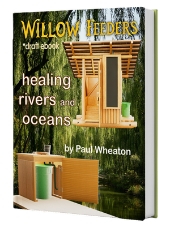
 1
1








 1
1




 , I do now see that along with the other request to not use plywood. Even without plywood, I would still keep the dimensions the same even if you were to use fencing.
, I do now see that along with the other request to not use plywood. Even without plywood, I would still keep the dimensions the same even if you were to use fencing.








 1
1




Kelly Kitchens wrote:Haven't had time to download Sketchup yet, though as a mechanical designer playing with it looks like fun. (So many projects, so little me to do them.)
I'm curious about something that might affect the design. I know that there are bears on and around the property... (Bear Spray thread) and that they've already done a little damage. One reason to pack your poo out when camping in bear territory (so I've been told) other than leave-no-trace is that bears will dig it up if buried.
Does this "wheeliepooper" need to be bear-proof? Is the poo likely to attract them? I'm having some pretty horrendous visions of what cleanup would be like if a bear got into a half-full Rubbermaid trash can...
Doing is Secondary to Being
 2
2






Permaculture is a gestalt ... a study of the whole. Not just how to produce more and better food, but how human life on the planet affects and is affected by the surrounding environment.
Bill Kearns




A human being should be able to change a diaper, plan an invasion, butcher a hog, conn a ship, design a building, write a sonnet, balance accounts, build a wall, set a bone, comfort the dying, take orders, give orders, cooperate, act alone, solve equations, analyze a new problem, pitch manure, program a computer, cook a tasty meal, fight efficiently, die gallantly. Specialization is for insects.
-Robert A. Heinlein

 3
3




some of what I'm up to: http://www.permies.com/t/34620/projects/acre












A human being should be able to change a diaper, plan an invasion, butcher a hog, conn a ship, design a building, write a sonnet, balance accounts, build a wall, set a bone, comfort the dying, take orders, give orders, cooperate, act alone, solve equations, analyze a new problem, pitch manure, program a computer, cook a tasty meal, fight efficiently, die gallantly. Specialization is for insects.
-Robert A. Heinlein
 1
1








A human being should be able to change a diaper, plan an invasion, butcher a hog, conn a ship, design a building, write a sonnet, balance accounts, build a wall, set a bone, comfort the dying, take orders, give orders, cooperate, act alone, solve equations, analyze a new problem, pitch manure, program a computer, cook a tasty meal, fight efficiently, die gallantly. Specialization is for insects.
-Robert A. Heinlein




 2
2




 1
1








Bill Kearns wrote:
Two steps up, with sideboards for reading material or laptops. Full length mirror, drawers, cupboard, and conveniently located sink.
Storage and fold-down access for three "cans", gravity-fed water catchment tank, and detachable step for moving the bivy.




paul wheaton wrote:... There will also be some sort of cob-like mass to hold heat through the night.
Mike
http://tenderfootfarmer.ca





Hans Albert Quistorff, LMT projects on permies Hans Massage Qberry Farm magnet therapy gmail hquistorff
 1
1




Moderator, Treatment Free Beekeepers group on Facebook.
https://www.facebook.com/groups/treatmentfreebeekeepers/









Hans Quistorff wrote:I would just cut the bottom out of the plastic garbage can and have it extend into a hole the size of the bottom of the container. When the hole fills up dig a new one beside the house lift the seat platform so that the can clears the ground and move it over. Use the dirt from the new hole to cover the old one and plant a tree.




Michael Cox wrote:Paul Wheaton - If you haven't already I strongly suggest reading the "Humanure Handbook". You should be able to do a search and get a pdf version. We have been using his system for years for both indoor and outdoor toilets. Absolutely no odour issues, rapid hot composting of waste, no flies etc...
I suspect that it will end up influencing your design choices a fair bit!








 2
2




some of what I'm up to: http://www.permies.com/t/34620/projects/acre




"You must be the change you want to see in the world." "First they ignore you, then they laugh at you, then they fight you, then you win." --Mahatma Gandhi
"Preach the Gospel always, and if necessary, use words." --Francis of Assisi.
"Family farms work when the whole family works the farm." -- Adam Klaus




R Scott wrote:My insight/observation is to use a double roof (kind of like a warre hive) to help with heat gain in the summer.




Adrien Lapointe wrote:
R Scott wrote:My insight/observation is to use a double roof (kind of like a warre hive) to help with heat gain in the summer.
What would that look like?

"You must be the change you want to see in the world." "First they ignore you, then they laugh at you, then they fight you, then you win." --Mahatma Gandhi
"Preach the Gospel always, and if necessary, use words." --Francis of Assisi.
"Family farms work when the whole family works the farm." -- Adam Klaus




 1
1




"You must be the change you want to see in the world." "First they ignore you, then they laugh at you, then they fight you, then you win." --Mahatma Gandhi
"Preach the Gospel always, and if necessary, use words." --Francis of Assisi.
"Family farms work when the whole family works the farm." -- Adam Klaus












Clear skies,
Brad Vietje
Newbury, VT
 5
5




![Filename: Squatty.jpg
Description: [Thumbnail for Squatty.jpg]](/t/25481/a/9526/Squatty.jpg)
I like this sort of thing.

|
So glamorous! Now do this tiny ad!
Freaky Cheap Heat - 2 hour movie - HD streaming
https://permies.com/wiki/238453/Freaky-Cheap-Heat-hour-movie
|









